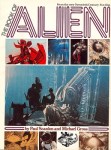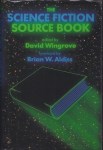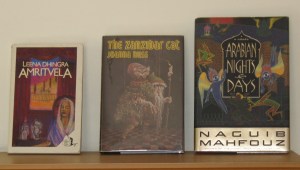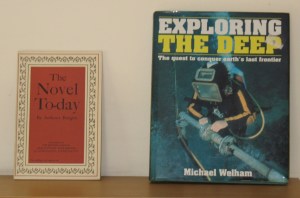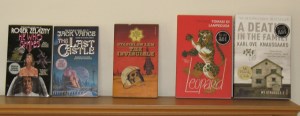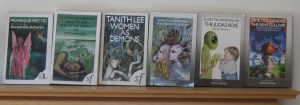Winter has definitely arrived and we’ve already had several days of snow. I’m a good deal further north than I used to be, although for much of the year so far that’s not really been apparent – it was hot during the summer, when it wasn’t wet and windy. But there’s definitely less daylight up here now that summer and autumn are over. After fifteen years in the UK, it’s nice to live somewhere that has clearly demarked seasons.
 Greeks Bearing Gifts, Philip Kerr (2018, UK). I’ve been a fan of the Bernie Gunther series for many years – and indeed of most of Kerr’s fiction (although, to be honest, a few of his thrillers are complete potboilers). Greeks Bearing Gifts is the thirteenth Bernie Gunther book, and the one following it, Metropolis, is unfortunately the last, as Kerr died last year. (And yes, I do have them all in first edition hardback.) Gunther is working as a porter at a hospital in Munich when he’s recognised by a local cop and blackmailed into assisting with a shakedown of a local bigwig with Communist connections. It goes wrong but gets Gunther a job at a reputable insurance company as an investigator. Which is why he ends up in Athens, investigating a claim for a yacht owned by a German that sank while searching for sunken treasure. Except, of course, nothing is ever that simple in a Bernie Gunther novel: and not only are the circumstances surrounding the sinking dodgy, but so too is the treasure they’re hunting – it’s gold stolen from Jews, basically – but then the owner of the yacht is murdered, and Bernie is up to his neck in events resulting from wartime incidents which he himself experienced but which make him look like a war criminal when he’s actually not one. They’re cleverly done these books, they treat their subject seriously. Kerr does his research and backs it up, and they show – through the point of view of a slightly corrupted witness – the many atrocities the Nazis committed and which people are now all too happy to dismiss. It’s quite simple: anyone who defends the Nazis is a Nazi. They were evil scum, and as the years pass and we learn quite how evil they actually were, so sympathising with them becomes even less justifiable. Bernie Gunther is a sympathetic character, and he worked with many Nazis – including a number of well-known ones, as is thrown in his face at one point in this novel. But he was never a Nazi and never sympathised with their views. And Kerr has used him extensively to criticise Nazi thought and views. It’s just a shame the people most likely to promote Nazi views are too stupid to read Kerr’s novel. Or indeed read books.
Greeks Bearing Gifts, Philip Kerr (2018, UK). I’ve been a fan of the Bernie Gunther series for many years – and indeed of most of Kerr’s fiction (although, to be honest, a few of his thrillers are complete potboilers). Greeks Bearing Gifts is the thirteenth Bernie Gunther book, and the one following it, Metropolis, is unfortunately the last, as Kerr died last year. (And yes, I do have them all in first edition hardback.) Gunther is working as a porter at a hospital in Munich when he’s recognised by a local cop and blackmailed into assisting with a shakedown of a local bigwig with Communist connections. It goes wrong but gets Gunther a job at a reputable insurance company as an investigator. Which is why he ends up in Athens, investigating a claim for a yacht owned by a German that sank while searching for sunken treasure. Except, of course, nothing is ever that simple in a Bernie Gunther novel: and not only are the circumstances surrounding the sinking dodgy, but so too is the treasure they’re hunting – it’s gold stolen from Jews, basically – but then the owner of the yacht is murdered, and Bernie is up to his neck in events resulting from wartime incidents which he himself experienced but which make him look like a war criminal when he’s actually not one. They’re cleverly done these books, they treat their subject seriously. Kerr does his research and backs it up, and they show – through the point of view of a slightly corrupted witness – the many atrocities the Nazis committed and which people are now all too happy to dismiss. It’s quite simple: anyone who defends the Nazis is a Nazi. They were evil scum, and as the years pass and we learn quite how evil they actually were, so sympathising with them becomes even less justifiable. Bernie Gunther is a sympathetic character, and he worked with many Nazis – including a number of well-known ones, as is thrown in his face at one point in this novel. But he was never a Nazi and never sympathised with their views. And Kerr has used him extensively to criticise Nazi thought and views. It’s just a shame the people most likely to promote Nazi views are too stupid to read Kerr’s novel. Or indeed read books.
 Farewell, Earth’s Bliss, DG Compton (1966, UK). Mars has become a new Botany Bay, and convicts are transported there at regular intervals. Life is brutal on Mars – although not as brutal as it would have been had Compton’s Mars been anything like the real Mars – as the latest group of transportees discover on arrival. I consider Compton one of the best science fiction writers the UK has produced. His prose is astonishingly good. But his best work was published in the 1970s and 1980s, and those books are very much of their time – to an extent, in fact, that it becomes part of their appeal. Farewell, Earth’s Bliss was Compton’s second sf novel – he had previously written crime fiction as Guy Compton, and continued for a few more years after his first sf novel. I’ve no idea why he decided to change genre. Perhaps he thought it would be easier to sell novels – although he doesn’t seem to have been discovered by the US until 1969, when his third sf novel, The Silent Multitude (see here), was published in the first Ace SF Special series. Anyway, Farewell, Earth’s Bliss owes much to Rex Gordon’s No Man Friday (see here), at least in terms of its depiction of the Red Planet. The characters are well-drawn but a deeply unpleasant bunch. And there’s a low level everyday racism – although one viewpoint character is black, and his narrative is handled sensitively – that does not sit well with modern readers. But, in common with other novels by Compton, it’s hard to see where the story is going. He was never one for plotting – perhaps that’s why he swapped from crime to science fiction, he couldn’t plot and could disguise that lack in sf – and Farewell, Earth’s Bliss is fairly typical in that regard. It reads like a series of character studies, something Compton did really well, although they work better when they’re in service to a barebones plot, which this novel lacks. It is a rare writer who impresses you with every book in their oeuvre, especially the early ones. Compton remains, to my mind, one of the best prose writers science fiction has produced, but that does not mean every book he wrote was amazingly good. (If you give a book five stars, what if you read one that’s even better? For fuck’s sake, give up with the juvenile “everything is awesome”, you’re not in the marketing department, you’re not being paid to make it easier for some multinational to rip you off.)
Farewell, Earth’s Bliss, DG Compton (1966, UK). Mars has become a new Botany Bay, and convicts are transported there at regular intervals. Life is brutal on Mars – although not as brutal as it would have been had Compton’s Mars been anything like the real Mars – as the latest group of transportees discover on arrival. I consider Compton one of the best science fiction writers the UK has produced. His prose is astonishingly good. But his best work was published in the 1970s and 1980s, and those books are very much of their time – to an extent, in fact, that it becomes part of their appeal. Farewell, Earth’s Bliss was Compton’s second sf novel – he had previously written crime fiction as Guy Compton, and continued for a few more years after his first sf novel. I’ve no idea why he decided to change genre. Perhaps he thought it would be easier to sell novels – although he doesn’t seem to have been discovered by the US until 1969, when his third sf novel, The Silent Multitude (see here), was published in the first Ace SF Special series. Anyway, Farewell, Earth’s Bliss owes much to Rex Gordon’s No Man Friday (see here), at least in terms of its depiction of the Red Planet. The characters are well-drawn but a deeply unpleasant bunch. And there’s a low level everyday racism – although one viewpoint character is black, and his narrative is handled sensitively – that does not sit well with modern readers. But, in common with other novels by Compton, it’s hard to see where the story is going. He was never one for plotting – perhaps that’s why he swapped from crime to science fiction, he couldn’t plot and could disguise that lack in sf – and Farewell, Earth’s Bliss is fairly typical in that regard. It reads like a series of character studies, something Compton did really well, although they work better when they’re in service to a barebones plot, which this novel lacks. It is a rare writer who impresses you with every book in their oeuvre, especially the early ones. Compton remains, to my mind, one of the best prose writers science fiction has produced, but that does not mean every book he wrote was amazingly good. (If you give a book five stars, what if you read one that’s even better? For fuck’s sake, give up with the juvenile “everything is awesome”, you’re not in the marketing department, you’re not being paid to make it easier for some multinational to rip you off.)
 Semiosis, Sue Burke (2018, USA). This was shortlisted for the Arthur C Clarke Award, and while I often disagree with the jury’s choices, there’s at least some expectation of quality in the books they pick. I mean, this is a national award. For science fiction. They might define the genre a little oddly every now and again, but they at least recognise good fiction when they see it. Except, well, maybe not last year. That was a really shit short list. Happily, the best book did indeed win. This year was quite an odd shortlist – the final book of a trilogy, a book of sf art, a horror novel, a debut novel, a mainstream novel that’s really sf, and… this, Semiosis. Which is certainly science fiction. It is, in fact, a first contact novel, and it says so on the cover. But it’s also surprisingly old-fashioned. I was reading sf like this back in the 1990s. The fact it’s done well doesn’t make it any more twenty-first century. The novel is structured as the diaries of members of a colony that has settled an alien world – a private venture, with very fixed ideas on minimising the colony’s impact on the alien world. The personal accounts follow on one generation from the next, first outlining the accommodations the colonists have made to survive, then the perversion of those accommodations in order to preserve ideals that no longer are relevant. Then the colonists learn there are others on the planet, descendants of colonists from an alien world. Where Semiosis differs from other first contact novels is that the major intelligence the colonists discover is a plant. And it more or less programmes the humans according to its own needs, which happily also result in some degree of success for the humans. That is until the humans meet the descendants of the prior alien colonists. There’s no denying Semiosis is done well, but there’s nothing I can see in it that makes it stand out from other well-crafted science fiction novels that privilege science. And while that may be a rarity in this day and age, it should not on its own be enough to merit appearance on a major genre award shortlist. Semiosis was good but I don’t think it deserved to be a Clarke finalist.
Semiosis, Sue Burke (2018, USA). This was shortlisted for the Arthur C Clarke Award, and while I often disagree with the jury’s choices, there’s at least some expectation of quality in the books they pick. I mean, this is a national award. For science fiction. They might define the genre a little oddly every now and again, but they at least recognise good fiction when they see it. Except, well, maybe not last year. That was a really shit short list. Happily, the best book did indeed win. This year was quite an odd shortlist – the final book of a trilogy, a book of sf art, a horror novel, a debut novel, a mainstream novel that’s really sf, and… this, Semiosis. Which is certainly science fiction. It is, in fact, a first contact novel, and it says so on the cover. But it’s also surprisingly old-fashioned. I was reading sf like this back in the 1990s. The fact it’s done well doesn’t make it any more twenty-first century. The novel is structured as the diaries of members of a colony that has settled an alien world – a private venture, with very fixed ideas on minimising the colony’s impact on the alien world. The personal accounts follow on one generation from the next, first outlining the accommodations the colonists have made to survive, then the perversion of those accommodations in order to preserve ideals that no longer are relevant. Then the colonists learn there are others on the planet, descendants of colonists from an alien world. Where Semiosis differs from other first contact novels is that the major intelligence the colonists discover is a plant. And it more or less programmes the humans according to its own needs, which happily also result in some degree of success for the humans. That is until the humans meet the descendants of the prior alien colonists. There’s no denying Semiosis is done well, but there’s nothing I can see in it that makes it stand out from other well-crafted science fiction novels that privilege science. And while that may be a rarity in this day and age, it should not on its own be enough to merit appearance on a major genre award shortlist. Semiosis was good but I don’t think it deserved to be a Clarke finalist.
 Throy, Jack Vance (1992, USA). So the Cadwal Chronicles comes to a close and it’s pretty much as expected, but this is Vance so it’s the journey that’s been the real source of entertainment. By the start of Throy, the conspiracy threatening Cadwal is pretty much understood. It seems to be driven chiefly by pique – the two sisters Spanchetta and Simonetta Clattuc couldn’t have Glawen Clattuc’s father, so they determined to destroy Cadwal’s society – in other words, the sort of brainless arrogance which seems to have been prevalent in British politics for the last fifteen years. Two factions want to open up Cadwal to exploitation – the LPF faction of the Naturalist Society, which owns Cadwal, wants a feudal society in which they lord it over vast estates of Yips, the planet’s servant race/class; while the two Clattuc sisters simply want to destroy the society in revenge. Unfortunately, the society’s ownership of Cadwal was safeguarded in the second book, Ecce and Old Earth (see here). Which means the two groups are forced to use more violent means to achieve their aims. Happily, the forces of good have a good idea of what is about to go down, and even though the novel is mostly a hunt for clues to resolve a couple of minor mysteries, and there’s a humongous atrocity which is pretty much passed over in a couple of paragraphs, everything works out pretty much as expected, and it’s all done very entertainingly. I’ve enjoyed these three books, more than I thought I would, and that’s despite being extremely familiar with Vance’s career. I’d happily recommend these above other better-known works by Vance.
Throy, Jack Vance (1992, USA). So the Cadwal Chronicles comes to a close and it’s pretty much as expected, but this is Vance so it’s the journey that’s been the real source of entertainment. By the start of Throy, the conspiracy threatening Cadwal is pretty much understood. It seems to be driven chiefly by pique – the two sisters Spanchetta and Simonetta Clattuc couldn’t have Glawen Clattuc’s father, so they determined to destroy Cadwal’s society – in other words, the sort of brainless arrogance which seems to have been prevalent in British politics for the last fifteen years. Two factions want to open up Cadwal to exploitation – the LPF faction of the Naturalist Society, which owns Cadwal, wants a feudal society in which they lord it over vast estates of Yips, the planet’s servant race/class; while the two Clattuc sisters simply want to destroy the society in revenge. Unfortunately, the society’s ownership of Cadwal was safeguarded in the second book, Ecce and Old Earth (see here). Which means the two groups are forced to use more violent means to achieve their aims. Happily, the forces of good have a good idea of what is about to go down, and even though the novel is mostly a hunt for clues to resolve a couple of minor mysteries, and there’s a humongous atrocity which is pretty much passed over in a couple of paragraphs, everything works out pretty much as expected, and it’s all done very entertainingly. I’ve enjoyed these three books, more than I thought I would, and that’s despite being extremely familiar with Vance’s career. I’d happily recommend these above other better-known works by Vance.
 Scoop, Evelyn Waugh (1933, UK). Well, if I’d thought Black Mischief (see here) was racist, it’s almost woke compared to Scoop. And yet Scoop is the Waugh novel which appears on so many best of lists, including “Best British Novels of All Time”. Of course, the people putting together these lists are not the ones who are troubled by the casual everyday racism embedded in them, but things have changed – for the better – and these works really should be re-evaluated in light of present-day sensibilities. And yes, I’m happy to call any right-winger a fascist, even if their views don’t fit the dictionary definition of fascism, let’s not forget taxonomy is a derailing technique and the only people who derail arguments are people who don’t want their views held up to public scrutiny. Because they’re probably fascist. Or racist. Like Scoop actually is. Its story is apparently inspired by real events, but it’s still a story about a white man – a hapless white man, it must be said – who goes to an “uncivilised” African country. Because all brown countries are, of course, uncivilised. At least to 1930s white people. But then, to add insult to injury, the text is filled with a number of racial slurs, not just spoken in dialogue, but in the actual descriptive prose. I lost count of them. The big joke is that a newspaper magnate has picked the wrong man – due to some confusion over names – to be his foreign correspondent covering a civil war in the invented African nation of Ishmaelia, but the Ishmaelians are too stupid and indolent to actually fight and all that happens is a series of contradictory communiques by government agencies. It’s a variation on Chesterton’s The Man Who Was Thursday, but written from a British colonialist perspective of the 1930s. Waugh was a terrible snob and a horrible person – it’s well-documented, he was deemed “officer most likely to be shot by his troops” during WWII – but he had a wonderful prose style. It’s a dilemma. His command of English is a joy to behold, but he wrote horribly racist and snobbish books (the latter allegedly presented as “comedy”). Read him and then throw his books away, that’s my strategy.
Scoop, Evelyn Waugh (1933, UK). Well, if I’d thought Black Mischief (see here) was racist, it’s almost woke compared to Scoop. And yet Scoop is the Waugh novel which appears on so many best of lists, including “Best British Novels of All Time”. Of course, the people putting together these lists are not the ones who are troubled by the casual everyday racism embedded in them, but things have changed – for the better – and these works really should be re-evaluated in light of present-day sensibilities. And yes, I’m happy to call any right-winger a fascist, even if their views don’t fit the dictionary definition of fascism, let’s not forget taxonomy is a derailing technique and the only people who derail arguments are people who don’t want their views held up to public scrutiny. Because they’re probably fascist. Or racist. Like Scoop actually is. Its story is apparently inspired by real events, but it’s still a story about a white man – a hapless white man, it must be said – who goes to an “uncivilised” African country. Because all brown countries are, of course, uncivilised. At least to 1930s white people. But then, to add insult to injury, the text is filled with a number of racial slurs, not just spoken in dialogue, but in the actual descriptive prose. I lost count of them. The big joke is that a newspaper magnate has picked the wrong man – due to some confusion over names – to be his foreign correspondent covering a civil war in the invented African nation of Ishmaelia, but the Ishmaelians are too stupid and indolent to actually fight and all that happens is a series of contradictory communiques by government agencies. It’s a variation on Chesterton’s The Man Who Was Thursday, but written from a British colonialist perspective of the 1930s. Waugh was a terrible snob and a horrible person – it’s well-documented, he was deemed “officer most likely to be shot by his troops” during WWII – but he had a wonderful prose style. It’s a dilemma. His command of English is a joy to behold, but he wrote horribly racist and snobbish books (the latter allegedly presented as “comedy”). Read him and then throw his books away, that’s my strategy.
 Planetfall, Emma Newman (2015, UK). These books have been recommended to me several times, although perhaps the third book, Before Mars, more than that others. And I’d had a vague ambition to give them a go, but then Planetfall was reduced to 99p for the ebook version so I though it worth a try. And I’m glad I did. From what I remember of the reviews, I had not thought it would appeal, but in actual fact it was much closer to my tastes in sf than I’d expected. There’s something in Planetfall that recalls a lot of older works – Rogue Moon is an obvious example – but also something very twenty-first century about the treatment. The narrator is member of a colony on an exoplanet. She is in charge of the colony’s 3D-printers, which has caused problems for her, as the novel slowly reveals. The colony is also sited juts outside an alien enigmatic and uninhabited city. The novel does not explain the alien city, but it uses it and its strange properties to open up the workings of the human colony. Planetfall is not only very readable, it also makes an excellent first of its premise. Perhaps I would have liked the alien city to be a little more explained, but Planetfall is the first in – to-date – a series of four books, and I plan to keep on reading, so how knows what will be revealed…
Planetfall, Emma Newman (2015, UK). These books have been recommended to me several times, although perhaps the third book, Before Mars, more than that others. And I’d had a vague ambition to give them a go, but then Planetfall was reduced to 99p for the ebook version so I though it worth a try. And I’m glad I did. From what I remember of the reviews, I had not thought it would appeal, but in actual fact it was much closer to my tastes in sf than I’d expected. There’s something in Planetfall that recalls a lot of older works – Rogue Moon is an obvious example – but also something very twenty-first century about the treatment. The narrator is member of a colony on an exoplanet. She is in charge of the colony’s 3D-printers, which has caused problems for her, as the novel slowly reveals. The colony is also sited juts outside an alien enigmatic and uninhabited city. The novel does not explain the alien city, but it uses it and its strange properties to open up the workings of the human colony. Planetfall is not only very readable, it also makes an excellent first of its premise. Perhaps I would have liked the alien city to be a little more explained, but Planetfall is the first in – to-date – a series of four books, and I plan to keep on reading, so how knows what will be revealed…
1001 Books You Must Read Before You Die count: 135


